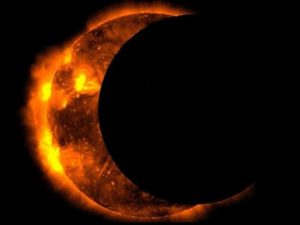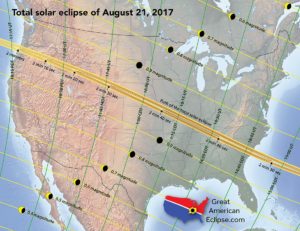By now, you’ve heard about the big event happening on August 21, 2017. No, we’re not talking about an amazing box office for The Dark Tower (though that wouldn’t surprise us). We’re talking about our solar system’s star attraction — the sun — and the upcoming solar eclipse this August. If you’re wondering what eclipse we’re talking about, and even if you’re not, we’ve got the scoop on what to expect.
Just what is a solar eclipse, anyway?

Photo Credit: NASA
It’s not dogs and cats living together and mass hysteria. It’s a happy coincidence of size and distance. While the sun is about 400 times greater in diameter than the moon, the moon is 400 times closer to earth than the sun. As a result, when the moon passes between the earth and sun, the earth falls in the moon’s shadow. And earthlings get a stellar display.
What makes this one special?
You may not realize it, but this year’s eclipse is unique in several ways. For starters, we haven’t seen a total eclipse from anywhere in the contiguous United States since 1979. It’s also the first total eclipse viewable only from the U.S. since 1776. And the path of totality hasn’t crossed from our west to east coasts in one fell swoop since 1918.
Where can we see the eclipse?
Though the eclipse path will cross from west coast to east coast in the U.S., that doesn’t necessarily mean you can see the totality of it from every location. Some spots will have better viewing than others.
 The good news is, the totality (meaning the moment the sun is completely obscured during the eclipse) will be visible from many major U.S. cities in states like Oregon, Wyoming, Tennessee, and South Carolina. This list from Great American Eclipse will help you figure out if you live near or can travel to a great viewing spot.
The good news is, the totality (meaning the moment the sun is completely obscured during the eclipse) will be visible from many major U.S. cities in states like Oregon, Wyoming, Tennessee, and South Carolina. This list from Great American Eclipse will help you figure out if you live near or can travel to a great viewing spot.
People outside the optimal viewing path — including various parts of North America, South America, Western Europe, and Africa — can still enjoy a partial eclipse.
When is the big event happening?
When exactly on Monday, August 21 should you look to the skies? Here’s a handy guide from NASA explaining what time you can see it in your area. But overall, here’s the lowdown: The eclipse happens in the late morning in the northwest, around noon in the Midwest, and early afternoon on the East Coast.
What should you expect if you’ve never seen an eclipse before?
The eclipse will last an hour and a half in its entirety, but that includes every inching moment. The actual length of totality only lasts about two minutes. So, make your plans accordingly.
Tips to optimize your viewing
First and foremost, don’t look directly at the sun! It sounds counterintuitive — after all, you want to see the eclipse, right? But looking at the sun, whether it’s being eclipsed or not, is a sure way to damage your eyesight. The only time you can look at the eclipse without protection is during the actual totality, if it’s happening where you live. Viewing the sun’s rays before and after totality, or during a partial eclipse, is just as dangerous as viewing the sun directly on a normal day.
The most popular way to view an eclipse safely is to create a pinhole camera or pinhole mirror, which is a fairly easy task. Less easy to acquire but still workable is finding aluminized Mylar or shade-14 arc welder’s glass, for those who want to go all in.

NPS Photo by Neal Herbert via Wikimedia
What doesn’t work: sunglasses and unprotected camera lenses. If you want to take pictures, consider setting up a tripod and programming the camera to take photos periodically during the eclipse. You can still use a pinhole device for viewing purposes.
What happens if you miss the eclipse?
Start your planning now, because the next total solar eclipse will take place above the skies of Mexico and Texas, through the Midwest and northeastern U.S. in 2024.